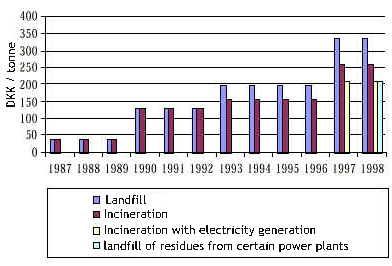[Front page] [Contents] [Previous] [Next] |
Effects of the increase in the danish waste tax
1. Introduction
Waste tax
The Danish waste tax first came into effect on 1st January 1987, and one of the purposes was to decelerate the development in waste amounts. Originally, the tax rate amounted to DKK 40/tonne of waste delivered to landfill or incineration, but the waste tax rate has been changed on several occasions, which is seen from figure 1.1. The tax rate has not only been increased, but also differentiated according to treatment option. The differentiation has contributed to giving a financial incentive to promote certain preferential treatment options. Waste that is recycled is exempt from the waste tax.

Figure 1.1. Development in waste tax rates 1987-1998
Significant increase in the waste tax rate in 1997
The significant increase in the waste tax that took effect on 1st January 1997 was primarily the result of the "green" tax reform in 1993, but also budget negotiations in 1996 contributed to the increase. The increase was adopted in 1993 to take effect in 1997, but during budget negotiations a further DKK 50/tonne waste was put on top of the rate. The negotiations resulted in the following tax rates:
| Waste tax (DKK/tonne) | 1996 | 1997 | Relative increase in per cent |
| Landfill | 195 |
335 |
72 |
| Other incineration | 160 |
260 |
63 |
| Incineration with electricity generation etc. | 160 |
210 |
31 |
| Weighted waste tax1 | 184 |
297 |
61 |
Table 1.1. Waste tax rate 1996 and 1997
Further differentiation of waste tax
Table 1.1 shows that the waste tax rate has increased significantly. Before 1997, the waste tax was differentiated by treatment option (landfill or incineration), and from 1.1.97 the waste tax was further differentiated between incineration with electricity generation and other incineration. However, the adopted increase in the waste tax led to different relative increases in the different tax rates. The tax for waste going to landfill increased by DKK 140/tonne from DKK 195/tonne in 1996 to DKK 335/tonne in 1997, corresponding to an increase in the waste tax rate of 72 per cent. The rate for waste going to incineration with heat recovery ("other incineration") increased by DKK 100/tonne, corresponding to an increase of 63 per cent, whereas the rate for waste incinerated with electricity generation etc. only increased by DKK 50/tonne, corresponding to an increase of 31 per cent. Based on the distribution between treatment options, the total weighted increase in the waste tax rate can be calculated to 61 per cent.
1987-1996
The development in taxable waste amounts from 1987 to 1996 was described and analysed in detail in Danish Environmental Protection Agency (1997). The report showed that net delivered waste amounts, i.e. waste delivered minus waste subsequently removed from municipal plants, from 1987 to 1996 decreased by 1,029,000 tonnes, corresponding to a decrease of 26 per cent. Correspondingly, net waste amounts delivered to small inert waste landfills and private landfills, which became taxable in 1990 due to an amendment in the taxation base, decreased from 1990 to 1996 by 155,000 tonnes, corresponding to a decrease of 39 per cent. The decrease in waste amounts took place before 1993, as the development in waste amounts stagnated from 1993 to 1996 (Danish Environmental Protection Agency, 1997: 40-41 and 52).
Waste tax: An important role
The evaluation presented in the report shows that the waste tax had played an important role for the decrease in taxable waste amounts from 1987 to 1993, but that the tax had only played a minor role for the development in industrial and commercial waste (Danish Environmental Protection Agency, 1997: 6-8). In detailed interviews with 16 enterprises it was seen that most enterprises indeed had taken initiatives to reduce waste generation, primarily by separating waste paper and ferrous scrap, but efforts were not focused, and very few enterprises had a precise knowledge of waste generation or costs of managing the different fractions.
Follow-up
The present follow-up of the Working Report from the Danish Environmental Protection Agency no. Xx 1997 "The Waste Tax 1987 – 1996 - an ex-post evaluation of incentives and environmental effects" therefore aims at:
| Surveying the development in waste amounts to and from waste treatment plants for the years 1997 and 1998 with a view to clarifying whether the increase and differentiation of the tax rate as from 1.1.97 have had any effect on the development in taxable waste amounts, | |
| Carrying out a detailed analysis of the development in waste amounts for a number of enterprises that have published data on waste generation etc. in connection with their green accounts. The analysis has a more quantitative approach than the study of enterprises in the Working Report No. 18 1999, but the quantitative analysis has been complemented by repeating the interviews that formed the basis for the study of enterprises in the previous report. |
_________________________
The weighted waste tax is based on the distribution of waste amounts delivered to incineration and landfill for "manufacturing industry etc." in 1996 and 1997 (cf. Danish Environmental Protection Agency, 1999).[Front page] [Contents] [Previous] [Next] [Top] |